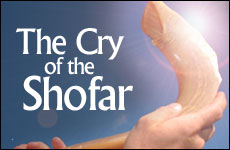 Identifying as a Jew
Identifying as a Jew


4 min read
From the narrow opening of the shofar, comes the wide expanse of relief.
Rosh Hashana seems like a holiday of tears. In the Torah reading, Hagar cries because Ishmael is left defenseless in the desert -- never mind that she walks away from the boy so she won't have to watch him die. In the Haftorah, Chana cries to be blessed with a baby while Penina mocks her for being childless. There is Sarah's happiness at giving birth to Isaac at the age of 99, but there is also the Akeida, the binding of Isaac. We know that Sarah is waiting in the wings, ready to expire just from hearing that he might have been killed. Again in the Haftorah Rachel cries for her children. And then there is the shofar itself. Its sound is linguistically sourced in Sisera's mother's cries when her son didn't return from war. Yom Truah, the day is called in the Torah, the day of groaning or wailing; not Rosh Hashana, the beginning of the year.
The shofar itself is a sequence of cries. It was sounded when the Torah was given. A midrash tells us that the people's souls flew out of them. The experience of receiving the Torah was an experience of terror: a trembling, a shaking, a fire. Shofar has a burning sound of urgency and fear. In fact the Hebrew word for burning (srifa) is close to the word for shofar. Yet the shofar is also sounded as a cry for war. In that wordless cry there is power.
The purpose of the tears is to be shocked, not into complacency but into elevation.
The shofar tells us that inside of all of us there is a place of darkness, of shock, of tears. But the shofar also reminds us of the word shipur, to improve, to get better. The shofar is supposed to remind us of the fact that Yitzhak was spared, that a ram was offered instead of a man. That is the purpose of the tears, of the wordless cry. Not to surrender to despair. To be shocked, not into complacency but into elevation, into making our lives an offering -- not by dying but by living and loving God.
It's not surprising that the sages tell us that the shofar will be blown at the end of days and to announce the resurrection of the dead. It is a link from Abraham to the giving of the Torah to the Messiah. It forms an aural chain through history, and a wake up call, as the Jews are supposed to be a wake up call. Wake up and see God's majesty in the world.
So the shofar is made of an animal's horn. Take God's creation -- the animal and the human together. And take the voice -- the breath that God blew into man, and make it manifest. Take what is invisible and bring it to life. Let God's voice speak in the shofar. Take that which is tied to the realm of animal and nature, and make it holy.
But the first step is the wordless cry. The Baal Shem Tov said: "The master key is the broken heart. When a man truthfully breaks his heart before God, he can enter into all the gates of the apartments of the King above all Kings, the Holy One, Blessed be He" (Ohr Yesharim). That cry is the broken heart. That is the cry of all of the mothers mentioned in the Torah and Haftorah readings on Rosh Hashana: Chana, Rachel, Sarah, and Hagar.
But the point is not the broken heart. The point is the redemption. The shofar is the voice of a greater truth. From the narrow opening of the shofar, comes the wide expanse of relief. Rachel's children will return to her borders. The mother's primal wrenching cry will be met with God's compassion. Our hope is that God will also cry for us, his children, that he will have mercy on us, and see us as a mother sees her child, perfect despite all of our faults.
